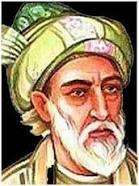Saib Tabrizi
| Saib Tabrizi | |
|---|---|
 | |
| Born |
1601 Tabriz,[1] Iran |
| Died |
1677 Isfahan, Iran |
| Occupation | Poet |
Saib Tabrizi (Persian: صائب تبریزی, Ṣāʾib Tabrīzī, میرزا محمّدعلی صائب تبریزی, Mīrzā Muḥammad ʿalī Ṣāʾib, Azerbaijani: Saib Təbrizi; 1601/02-1677) also called Saib Isfahani (Persian: صائب اصفهاني, Ṣāʾib Eṣfahānī) was a Persian[2][3][4][5][6] poet and one of the greatest masters of a form of classical Arabic and Persian lyric poetry characterized by rhymed couplets, known as the ghazal. Besides writing in Persian, Saib was known to have written 17 ghazals and molammaʿs in Azeri.[7]
Saib was born in Tabriz, and educated in Isfahan and in about 1626/27 he traveled to India, where he was received into the court of Shah Jahan. He stayed for a time in Kabul and in Kashmir, returning home after several years abroad. After his return, the emperor of Persia, Shah Abbas II, bestowed upon him the title King of Poets.
Saib's reputation is based primarily on some 300,000 couplets, including his epic poem Qandahār-nāma (“The Campaign Against Qandahār”). (The city of Qandahār or Kandahar in today's Afghanistan was in Saib Tabrizi's lifetime a long-standing bone of contention between the Mughal rulers of India and the Safavid rulers of Persia - both of whom were at different times the poet's patrons - until definitely given over to Persian rule as a result of the Mughal–Safavid War of 1649–53.)
Saib Tabrizi's “Indian style” verses reveal an elegant wit, a gift for the aphorism and the proverb, and a keen appreciation of philosophical and intellectual exercise. Saib was especially well known for his Persian panegyric poetry during the reigns of Persian Emperors Safi, Abbas II and Suleiman.[8]
A line from Saib's poem on Kabul provided the title for Khaled Hosseini's 2007 novel, A Thousand Splendid Suns.
Biography
He was born in 1601 in [Tabriz]. His family was one of a thousand families who had migrated from Tabriz to Isfahan with direct order of Abbas I of Persia which called Isfahan's Tabareze (People from Tabriz who lived in Isfahan).[9]
His father was one of the famous traders in Isfahan.
He traveled to Mecca for Haj and Mashhad (two famous holy cities for Muslims) in his youth.
In 1635 he traveled to India and after that to Herat and Kabul.
Saib method in poetry
He developed a method which called Indian method.[10]
پاکان ستم ز جور فلک بیشتر کشند گندم چو پاک گشت خورَد زخم آسیا
همچو کاغذباد گردون هر سبکمغزی که یافت در تماشاگاه دوران میپراند بیشتر
اظهار عجز نزد ستم پیشه ابلهیست اشک کباب موجب طغیان آتش است
به فکر معنی نازک چو مو شدم باریک چه غم ز مویشکافان خردهبین دارم
پر در مقام تجربت دوستان مباش صائب غریب و بیکس و بییار میشوی
Poem
Persian poems
آب خضر و می شبانه یکیست مستی و عمر جاودانه یکیست
بر دل ماست چشم، خوبان را صد کماندار را نشانه یکیست
پیش آن چشمهای خوابآلود نالهٔ عاشق و فسانه یکیست
پلهٔ دین و کفر چون میزان دو نماید، ولی زبانه یکیست
گر هزار است بلبل این باغ همه را نغمه و ترانه یکیست
پیش مرغ شکستهپر صائب قفس و باغ و آشیانه یکیست
Turkish poems
مین دل محزونیله بیر تازه قربانیز هله زخم تیر غمزه مستینله بیجانیز هله
اولمادان غم چکمه ریز دور زمانیندان سنین ناله و آه ایتمه ده دل ایندی حیرانیز هله
لطف ایدرسن، گر چه سن اغیاره هر دم دوستیم روز و شب بیز فرقتینله زار و نالانیز هله
عید وصلینه مشرف اولمادان اغیار دون دستینی بوس ایله دیک بیزاونلا شادانیز هله
دام دوزخ ایچره اغیار اولماسین اصلاً خلاص صائبا بیز جنت دلداره مهمانیز هله
See also
References
- ↑ PAUL E. LOSENSKY, "Sa'eb Tabrizi" in Encyclopedia Iranica "ṢĀʾEB of TABRIZ, Mirzā Moḥammad ʿAli (b. Tabriz, ca. 1000/1592; d. Isfahan, 1086-87/1676), celebrated Persian poet of the later Safavid period. "
- ↑ Donzel, E. J. van (1 January 1994). Islamic Desk Reference. BRILL. p. 385. ISBN 90-04-09738-4.
Saib*, Mirza Muhammad Ali*: Persian poet; 16031677. He was one of the most prolific poets of his time, and is highly praised by Oriental critics.
- ↑ PAUL E. LOSENSKY, "Sa'eb Tabrizi" in Encyclopedia Iranica "ṢĀʾEB of TABRIZ, Mirzā Moḥammad ʿAli (b. Tabriz, ca. 1000/1592; d. Isfahan, 1086-87/1676), celebrated Persian poet of the later Safavid period. "
- ↑ Safavid Iran, p 91.
- ↑ Maapri Publication of Rajastan, India, (Retrieved on: 2 January 2009)
- ↑ "Ṣāʾib." Encyclopædia Britannica from Encyclopædia Britannica 2007 Ultimate Reference Suite .(2008)
- ↑ Azeri Literature in Iran:"In addition to his Persian works, the great poet of the period Mirzā Moḥammad-ʿAli Ṣāʾeb Tabrizi (d. 1670) wrote 17 ḡazals and molammaʿs in his native Turkish Tabriz (Yazıcı, s.v. “Sâib,” in İA X)."
- ↑ Safavid Iran, p 91.
- ↑ Ghahraman, Mohammad (Winter 1991). Rangin Gol. Tehran: Sokhan publication. p. 7.
- ↑ Ghahraman, Mohammad (Winter 1991). Rangin Gol. Tehran: Sokhan publication. p. 8.
External links
| Wikimedia Commons has media related to Saib Tabrizi. |
- A poem by Saeb, after his visit from the Kabul city
Sources
- J. Newman, Andrew, Safavid Iran: Rebirth of a Persian Empire, I.B.Tauris, 2006, ISBN 1-86064-667-0, ISBN 978-1-86064-667-6.
- "Ṣāʾib." Encyclopædia Britannica from Encyclopædia Britannica 2007 Ultimate Reference Suite .(2008)
- Etelaat newspaper, 2014